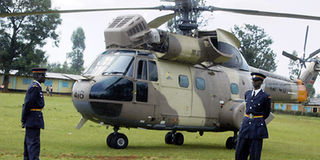Fuel leak forces down Kibaki military helicopter

Police officers guard President Kibaki's helicopter at Marani primary school in the Nyanza district of Kisii where it was left after it developed mechanical problems. Photo/JACOB OWITI
A fuel leak may have forced President Kibaki’s military helicopter to make an emergency landing with the Head of State on board in the Nyanza district of Kisii on Wednesday, sending a ripple of concern through a country scarred by air disasters.
Chief of General Staff Jeremiah Kianga told the Nation that the President was in no danger, but witnesses described fire and a cloud of smoke billowing out of one of the chopper’s engines immediately the aircraft was airborne.
An Air Force pilot said the incident, which he described as “minor” was almost certainly caused by a fuel leak. The pilot, who cannot be named because he is not authorised to speak to the media, said the leak had nothing to do with maintenance. He said such a leak could be caused by a malfunctioning seal.
“From the outside, it looks like there is a fire but the flying instruments do not register it,” the pilot added. The pilot immediately landed the chopper, apparently on noticing the crowd of onlookers and policemen on the ground, who thought it was on fire, fleeing.
The President’s Kenya Air Force Puma chopper had just taken off from St Monica Marani Secondary School playground in Kisii at 12.50pm with Mr Kibaki, his private secretary, Prof Nick Wanjohi, the Aide de Camp, the head of the Presidential Escort and director of the Presidential Press Service on board.
“The President had just boarded his military helicopter after addressing a public rally at Marani shopping centre in Kitutu Chache when a huge smoke emerged, forcing the pilot to swiftly switch off the engine,” Mr Dominic Nyarora, who was at the scene, said.
The presidential guard surrounded the aircraft and signalled to the pilot to switch off the engine, which appeared to be on fire. The President was led to a second helicopter, which flew him to Nyamira to continue his schedule, said Mr Nyarora.
Another witness, Mr Richard Ogeto, said he saw smoke as the chopper was lifting off and security staff signalled the pilot to land. “Ministers were to board their plane. When the plane landed, I saw smoke and people including policemen started running away,” he added.
The Kisii council fire brigade, which was on site, quickly put out the engine fire, said the witness. Hundreds had turned up to witness the official announcement of the newly created Marani District.
Area DC Benjamin Njoroge described the incident as a minor technical, hitch which the pilot detected in good time. But in the small rural trading centre of Marani, life stopped as traders shut their businesses and fled, fearing an explosion.
In a statement, Gen Kianga said one of the engines malfunctioned, forcing the pilot to make an emergency landing. “The Ministry of State for Defence wishes to report to the public that this afternoon at around 1300 hours, one of the two engines of the military Puma helicopter which was ferrying the President from Marani to Kibabe in Kisii North District malfunctioned on take off.
“On noticing this, the pilot elected to land immediately as is the drill in such situations,” the statement, signed by military spokesman Bogita Ongeri on behalf of the CGS, said.
DOD said throughout the incident the President was not exposed to any danger. “On landing, he (President) was immediately transferred to the support helicopter which took him to Kibabe where he arrived on time and continued with his programme.”
The Pumas used by the Air Force are manufactured by a French firm. The one used by the President has been in service since the late 1970s, a Kenya Air Force officer said, and is one of two still in use. “The planes are maintained by the Kenya Air Force to the highest standards,” the officer, who cannot be named because of military discipline.
Moving soldiers
The chopper, the source said, is not used exclusively by the President, but is routinely used to move soldiers. Whenever the President wishes to use it, it is configured and put into what is known in military parlance as presidential mode. In the presidential mode, the helicopter is fitted with a toilet, soundproofing and a public address system added.
Parents, who were accompanied by their children to see the President, ran helter-skelter looking for their children in panic. Mrs Florence Kerubo said she found her three-year-old son in a nearby banana plantation. By late evening, the pilots cracked open the engine to cool as they waited for engineers from Nairobi.
By Dan Otieno, Benson Nyagesiba, Henry Nyarora and Jackline Moraa




